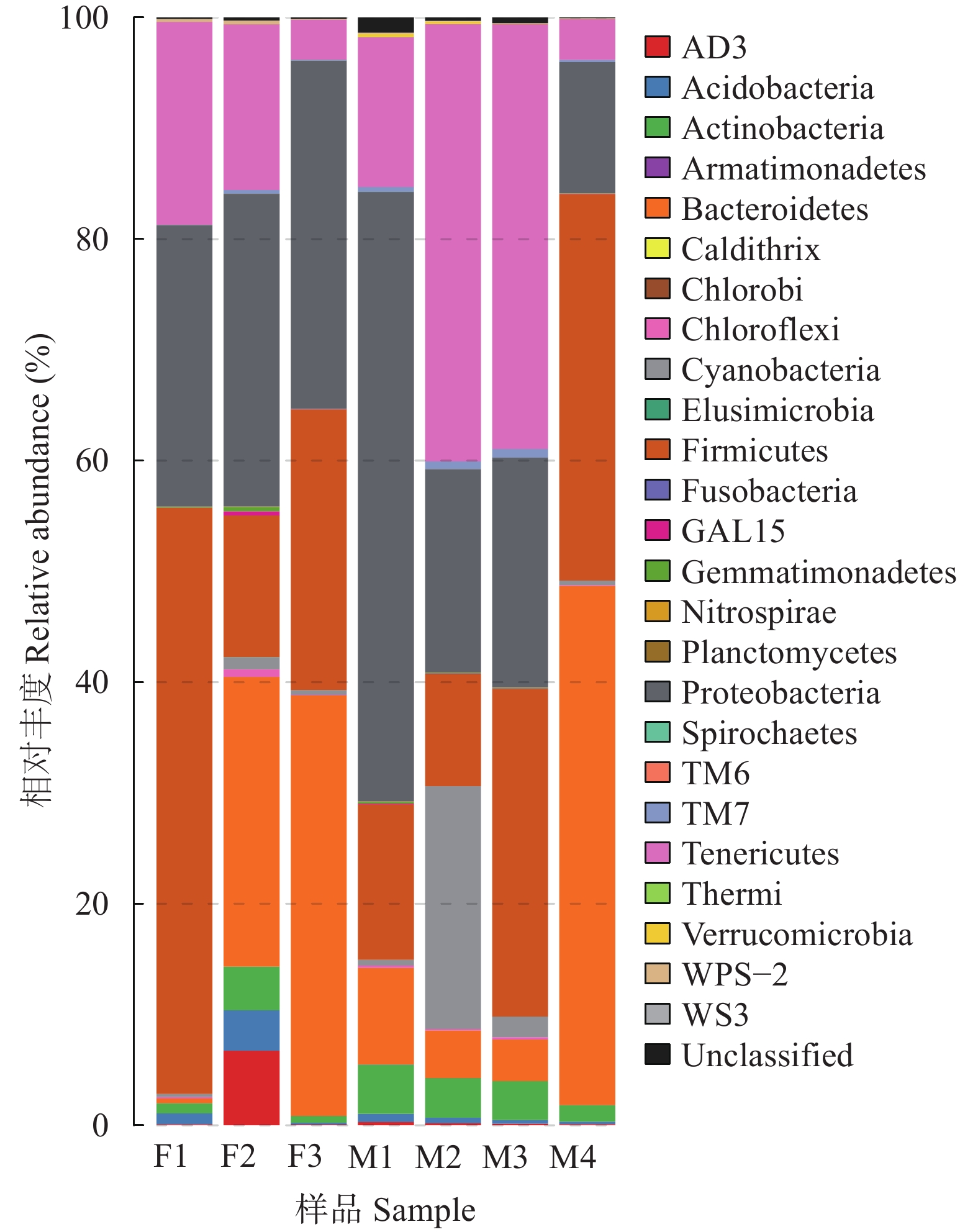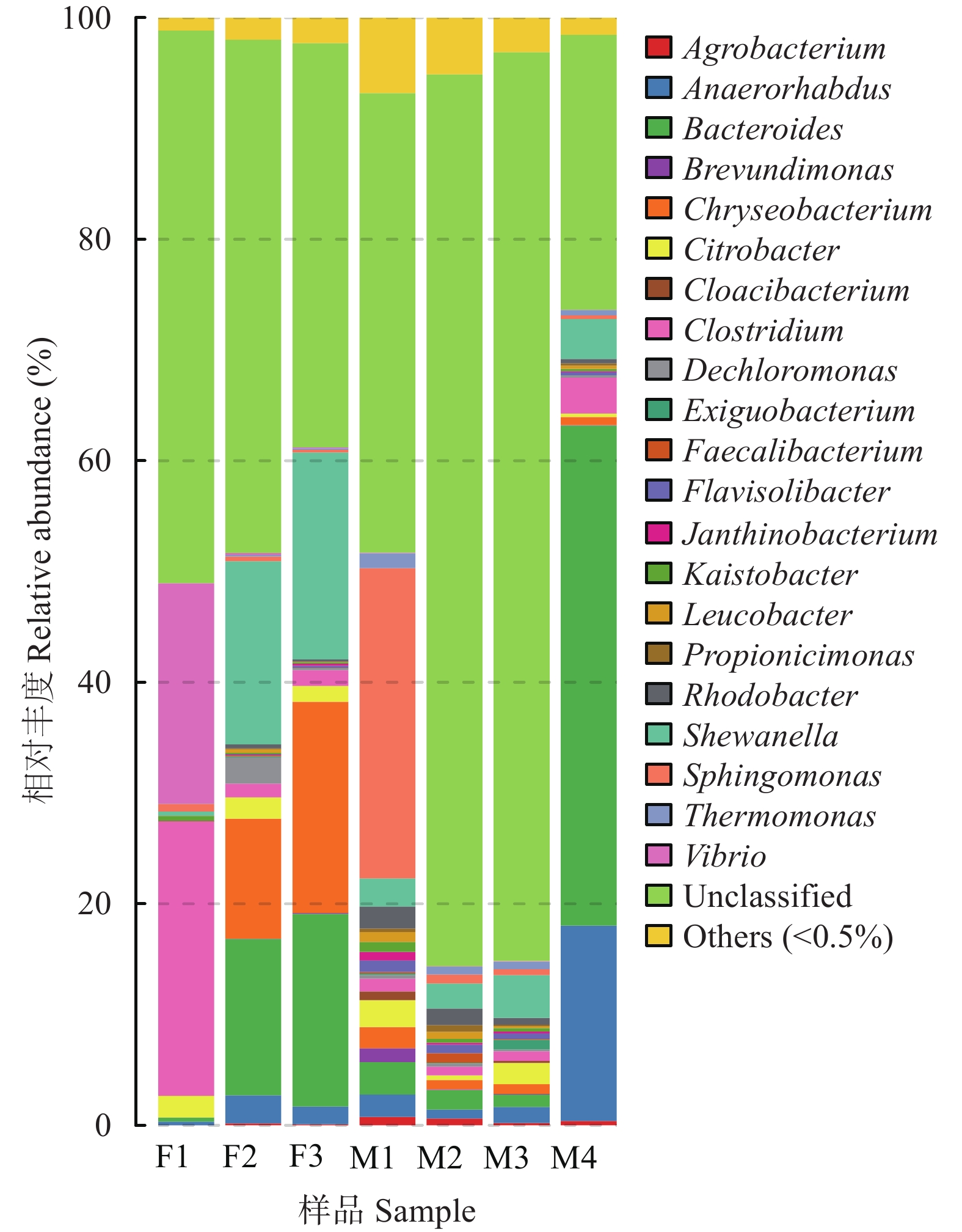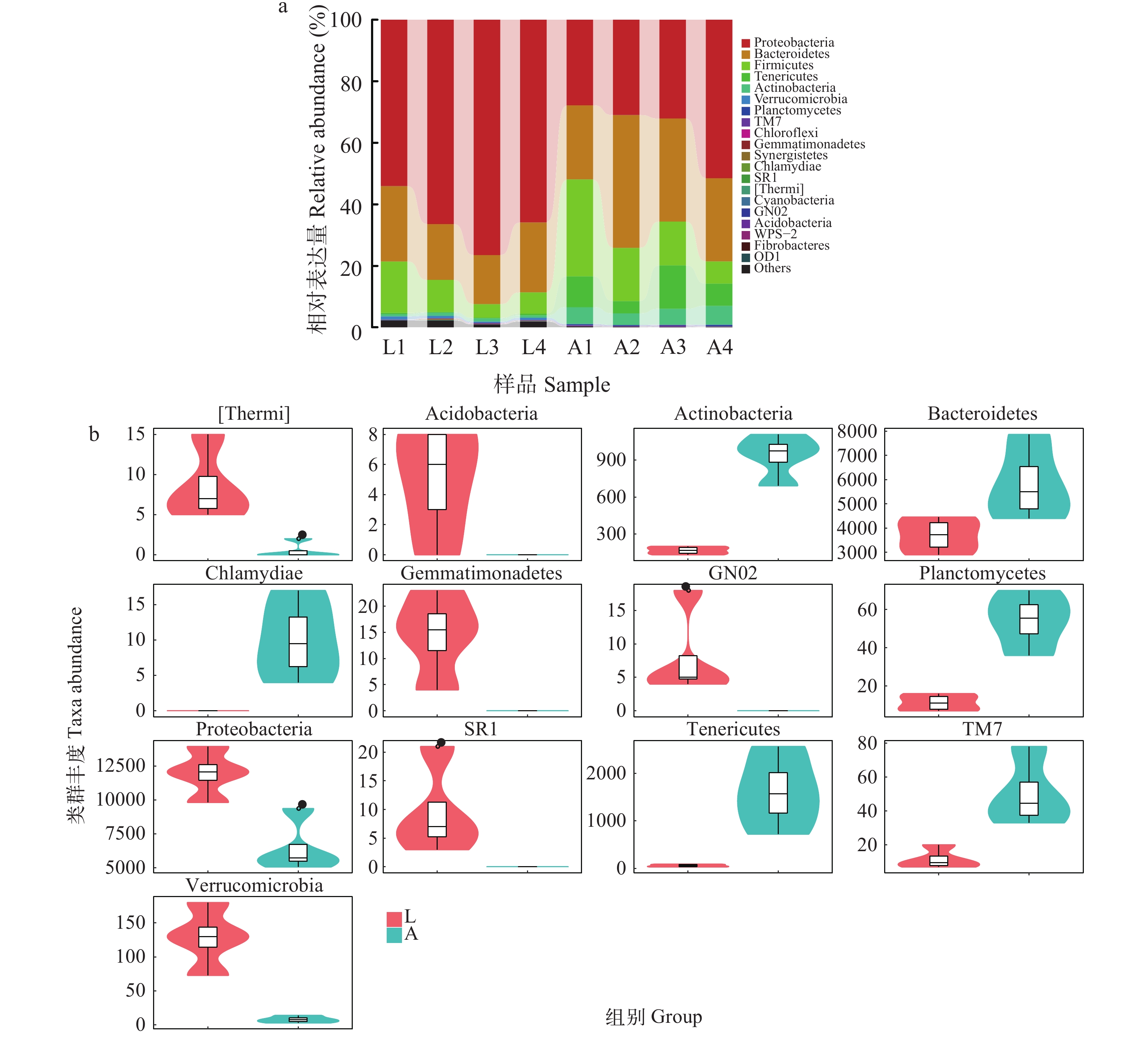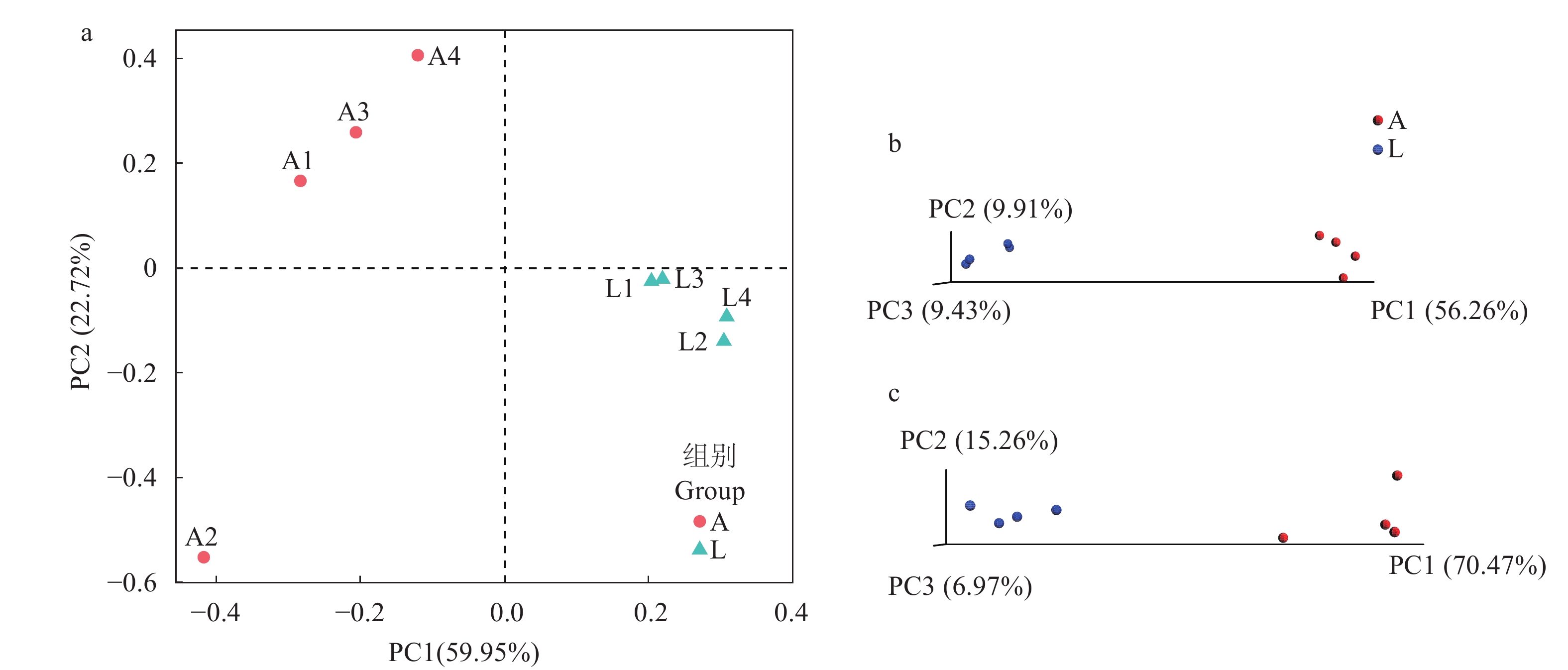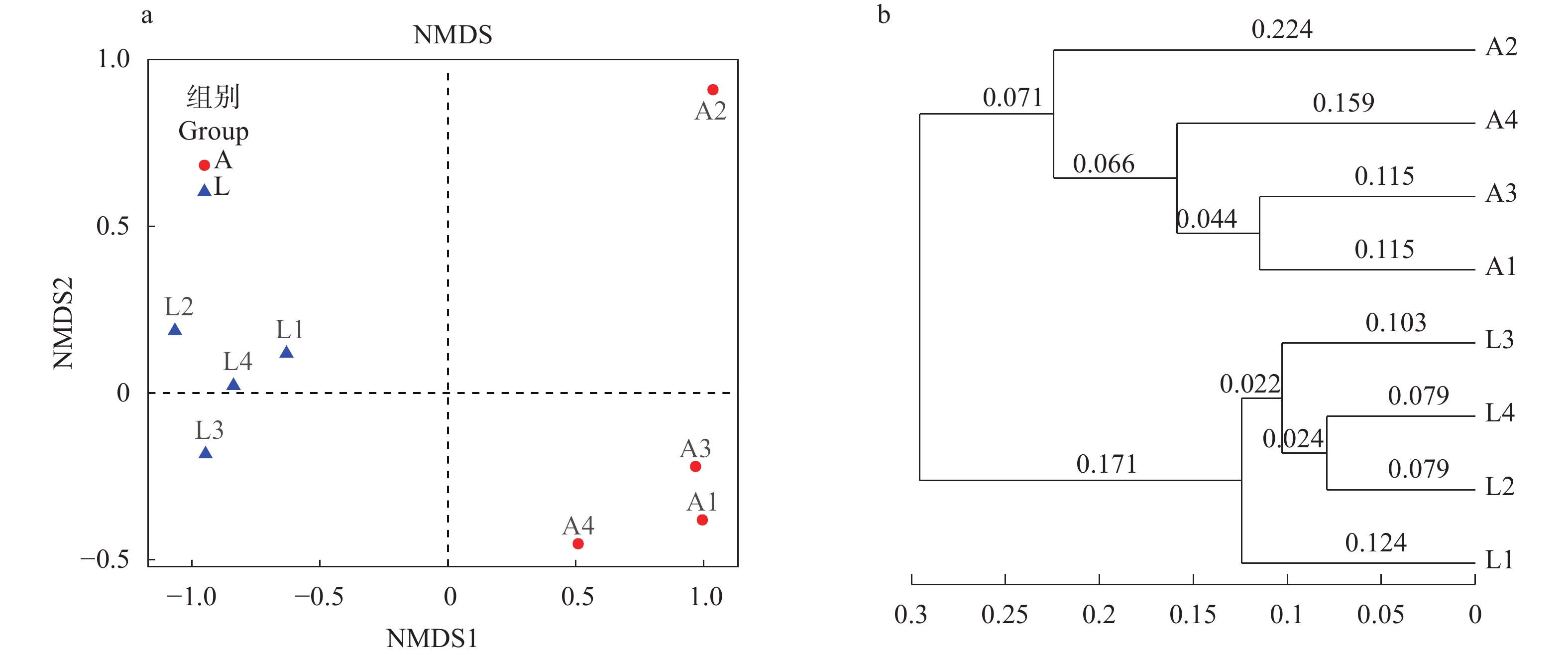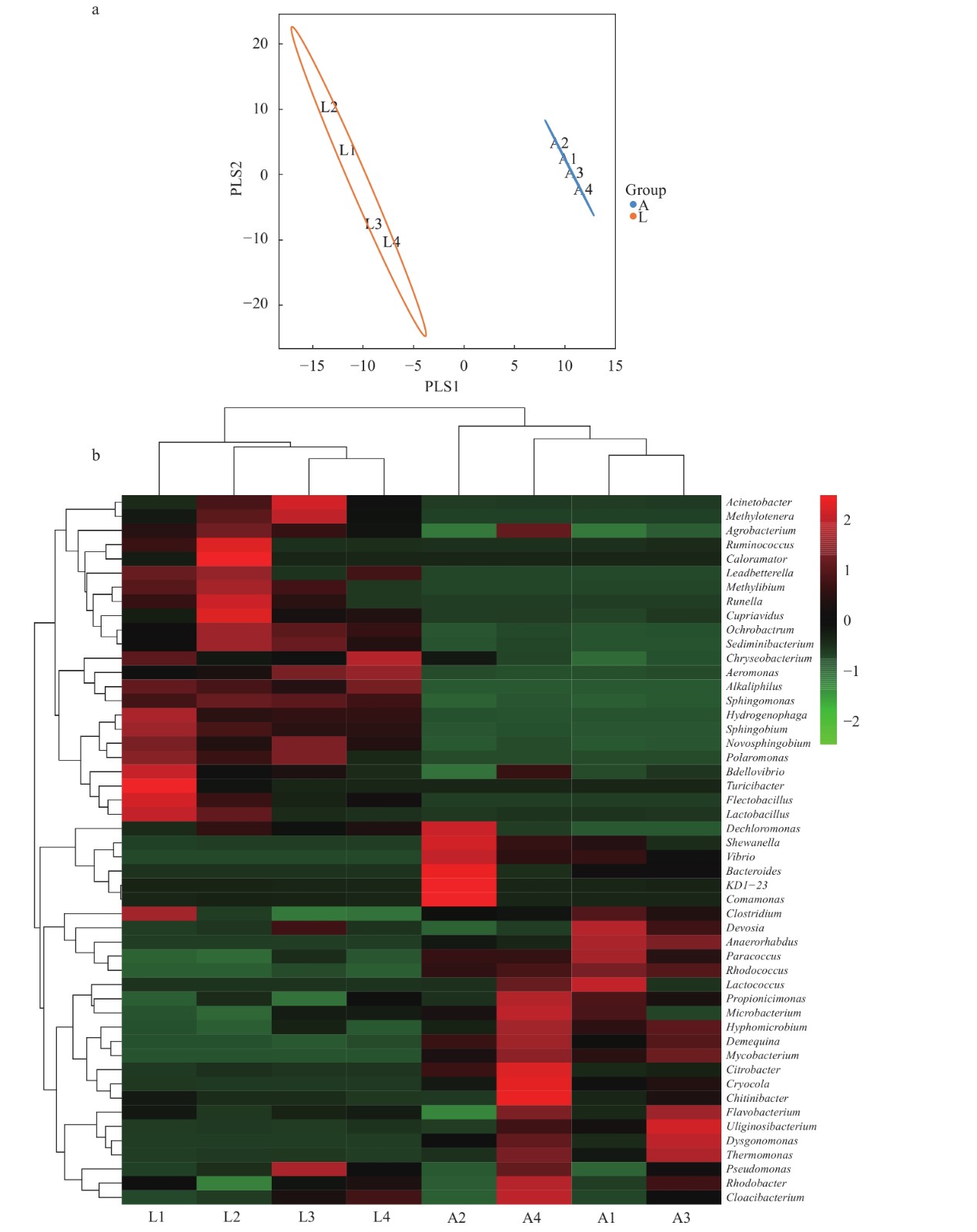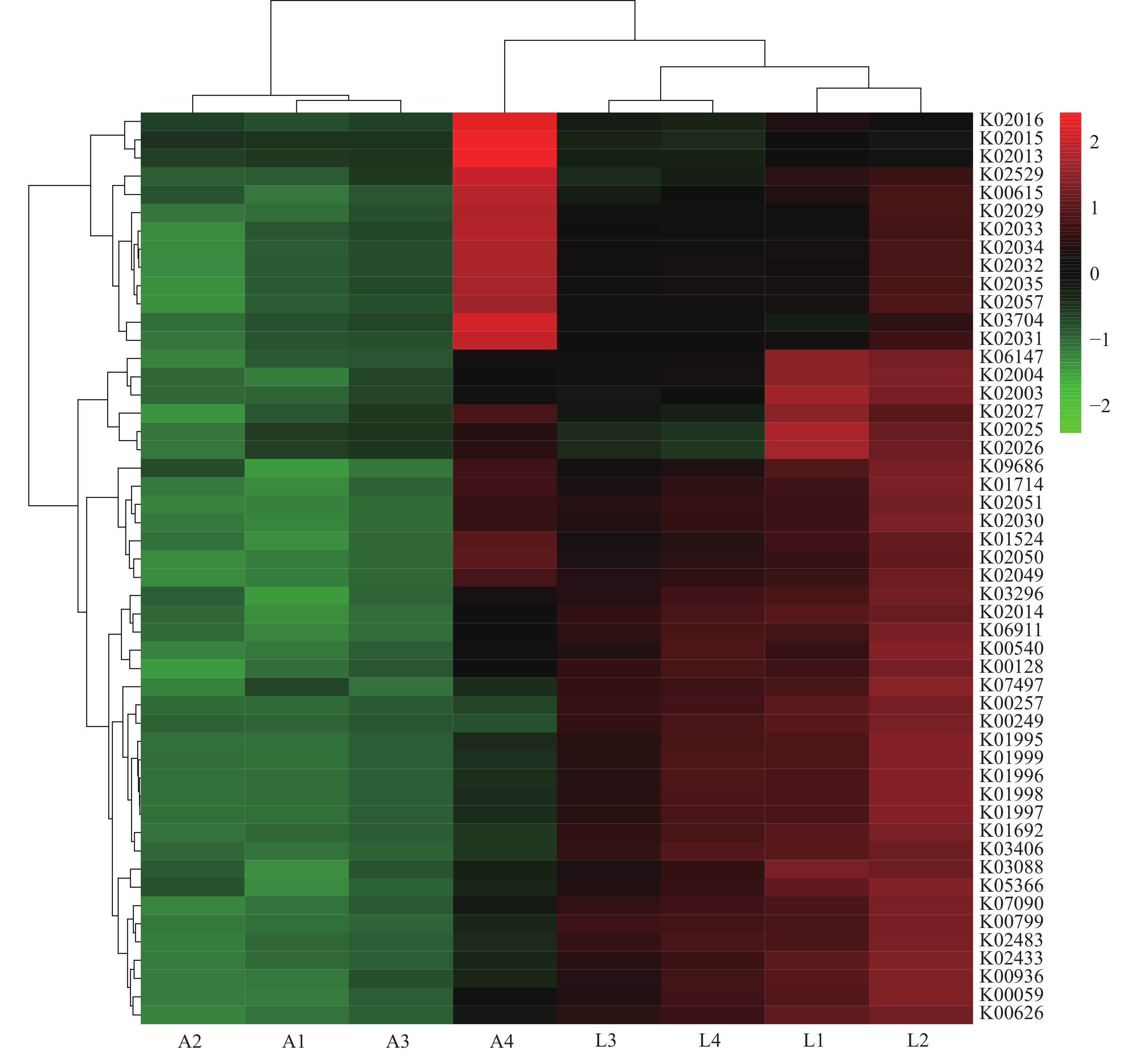THE INTESTINAL MICROBIOTA DIVERSITIES OF PROCAMBARUS CLARKIA AT DIFFERENT SEXES AND GROWTH STAGES
-
摘要: 为研究性别和生长阶段对克氏原螯虾(Procambarus clarkii)肠道菌群的影响, 实验对来自虾塘的雌雄成虾肠道样品及来自实验室养殖的幼虾和成虾的肠道样品进行了16S rRNA高通量测序分析。结果表明, 不同性别间克氏原螯虾肠道菌群的多样性和功能均没有显著性差异(独立样本t检验: P>0.05), 其优势菌群在门水平上均包括厚壁菌门(Firmicutes)、变形菌门(Proteobacteria)和拟杆菌门(Bacteroidetes)等; 属水平上包括拟杆菌属(Bacteroidia)、希瓦氏菌属(Shewanella)、梭菌属(Clostridium)和柠檬酸杆菌属(Citrobacter)等; 但各优势菌群在个体间的丰度差异较大, 且在成虾阶段趋于保守, 属肠道常驻菌群。幼虾肠道菌群的Alpha多样性显著高于成虾(独立样本t检验: P<0.05)。在门水平上, 优势菌群较为一致, 包括变形菌门、拟杆菌门、厚壁菌门和放线菌门(Actinobacteria)。成虾厚壁菌门与拟杆菌门的比例高于幼虾, 表明成虾分解食物和吸收营养的潜力更强。在属水平上, 成虾和幼虾肠道中均存在大量的黄杆菌属(Flavobacterium)、拟杆菌属和氢噬胞菌属(Hydrogenophaga), 这些菌属可以帮助机体进行多种营养代谢, 成虾肠道中与碳水化合物代谢相关的菌群多于幼虾。PICRUSt功能预测显示, 在克氏原螯虾肠道中, 营养代谢功能相关的菌群相对丰度最高, 而成虾肠道菌群代谢碳水化合物的功能显著高于幼虾。实验表明, 在野外虾塘养殖下的克氏原螯虾的肠道菌群不论是在群落多样性、物种丰度还是菌群功能预测上, 都未体现出性别间的差异, 且肠道菌群的个体差异较大; 但在不同生长阶段间, 克氏原螯虾肠道微生物的群落多样性、丰度及功能都有显著差异, 相比于幼虾, 成虾肠道菌群多样性降低, 多种代谢功能升高。Abstract: As one of the most important economic animals in China, red swamp crayfish (Procambarus clarkii) has been in short supply in recent years, and the market has put forward higher requirements for the production and quality of red swamp crayfish. To study the intestinal microbiota in red swamp crayfish at different sexes and stages of growth, we collected male and female adult crayfish of (27.00±1.50) cm in length from the natural environment and larval crayfish of (2.00±0.20) cm in length from lab, respectively, 16S rRNA high-throughput sequencing. The results showed that there were no significant difference in the diversity or function of the intestinal microbiota between different sexes, and the composition was relatively consistent (Independent sample t-test, P>0.05). The dominant bacterial phyla included Firmicutes, Proteobacteria and Bacteroidetes, and bacterial genera included Bacteroidia, Shewanella, Clostridium and Citrobacter. The abundances of dominant bacterial groups varied greatly among individuals. These dominant bacterial groups tended to be conservative in adult crayfish intestine as resident microorganisms. The analysis of Beta diversity showed that male and female crayfish samples were not clustered separately, which indicated no significant difference between male and female crayfish. Among the intestinal microbiota at different growth stages, the Alpha diversity indexes of intestinal microbiota in larval crayfish were significantly higher than those in adult crayfish (Independent sample t-test, P<0.05). In terms of the composition and structure at the phylum level, the dominant bacterial groups in two stages were relatively consistent, including Proteobacteria, Bacteroides, Firmicutes, and Actinobacteria. The ratio of Firmicutes to Bacteroides in adult crayfish was higher than that in larval crayfish, indicating that the adult crayfish has a greater potential to digest foods and absorb nutrients. At the genus level, the composition of the dominant genera in the two stages of growth were quite different. The dominant genera of larval crayfish included Unclassified_Burkholderiales (21.1%), Hydrogenophaga (7.6%), Flavobacterium (7.4%), Unclassified_Comamonadaceae (5.4%) and Alkaliphilus (5.2%). The dominant genera of adult crayfish included Bacteroidia (12.5%), Flavobacterium (10.8%), Paracoccus (9.1%) and Unclassified_ Lachnospiraceae (5.5%). The top 20 most diverse genera of adult and larval crayfish included Mycoplana, Asticcacaulis, Sphingomonas, Alkaliphilus, Novosphingobium, Methylopila, Sphingobium, Dyadobacter, Rhodococcus, Hydrogenophaga, Mycobacterium, Tepidibacter, Demequina, Kaistobacter, Ancylobacter, Delftia, Ochrobactrum, Rheinheimera, Methyloversatilis and Sediminibacterium. A large number of Flavobacterium, Bacteroidetes and Hydrogenophaga in the intestines of adult and larval crayfish help the body to carry out a variety of nutrient metabolisms and there were more bacteria related to carbohydrate metabolism in adult crayfish. The Beta diversity of intestinal microbiota showed that adult and larval crayfish samples were clustered separately in PCA analysis, PCoA analysis, NMDS analysis, UPGMA cluster analysis and PLS-DA analysis, indicating great difference between adult and larval crayfish. In addition, the analysis of Adonis/PERMANOVA showed significant difference in the intestinal microbiota between adult and larval crayfish. PICRUSt function prediction showed that the relative abundance of nutrient metabolism function was the highest in the functions of intestinal microbiota in crayfish. The dominant functions of intestinal microbiota in adult crayfish included membrane transport and carbohydrate metabolism, the dominant functions of larval crayfish included cell movement, biodegradation and metabolism of xenobiotics and lipid metabolism. The abundance of metabolizing carbohydrates in adult crayfish was significantly higher than that of larval crayfish. During the breeding cycle of red swamp crayfish, the diet habits will change from plankton to granular feed as the development of crayfish. The capacity of secreting various digestive enzymes in the intestine is enhanced, accompanied by the changes of intestinal microbiota in composition and function to adapt to the shift in diet habits. Our results provide reliable data support and theoretical guidance for the subsequent improvement of the production and quality of red swamp crayfish, the selection of intestinal probiotics and the study of probiotic preparations.
-
Keywords:
- Procambarus clarkii /
- Intestinal microbiota /
- High-throughput sequencing /
- Sex /
- Growth stage
-
肠道微生物生活在动物胃肠道黏膜和内容物中, 在长期的进化过程中, 与宿主之间形成了极为密切的关系。在正常生理状态下, 肠道微生物之间通过相互作用维持着动态平衡, 共同影响宿主的营养、免疫、生产性能、生理状态和疾病等过程[1, 2]。研究表明, 许多肠道微生物可以分泌消化酶, 分解饲料中的淀粉和纤维素等物质, 为机体提供短链脂肪酸、氨基酸和维生素等[3], 促进机体的营养吸收[4]。许多微生物还可以促进宿主免疫系统(包括免疫细胞和免疫组织)的发育[5], 并通过影响黏膜分泌免疫球蛋白、非特异性免疫和免疫应答等过程提高机体的健康状况[6]。因此, 维持肠道菌群的稳态对提升宿主健康水平和促进宿主生长发育具有重要意义。
影响肠道菌群稳态的因素有很多, 例如宿主基因型、性别、环境、生长阶段和食物等。这在哺乳动物中已有广泛研究, 在鱼类中的研究也有较多报道[7-12]。在甲壳动物中, 有研究发现中华绒螯蟹(Eriocheir sinensis)成年雌性蟹的细菌群落多样性高于雄性蟹, 不同生长阶段各细菌比例不同, 优势细菌的丰度发生了显著变化; 雌性和雄性蟹具有相同的优势细菌, 且菌群丰度随生长阶段发生的变化在雄蟹和雌蟹中显示出一致的趋势[13]。对虾类肠道菌群的研究大多关注与疾病发生相关的微生物组成变化[14, 15], 目前已有研究者对中国对虾(Penaeus chinensis)、日本对虾(Penaeus japonicus)、凡纳滨对虾(Litopenaeus vannamei)和墨吉对虾(Penaeus merguiensis)等虾类早期发育阶段的肠道菌群进行了分离鉴定[16-19]。但关于克氏原螯虾(Procambarus clarkii)肠道菌群在不同性别和不同生长阶段之间的差异还未见报道。
克氏原螯虾是一种淡水虾类, 是我国重要的经济养殖虾类之一[20]。本实验通过16S rRNA高通量测序的方法, 对自然环境中不同性别的克氏原螯虾以及实验环境下不同生长阶段的克氏原螯虾肠道菌群组成及功能进行了分析, 为克氏原螯虾生长过程中肠道益生菌的筛选及克氏原螯虾养殖产业中益生菌制剂的研究提供科学依据和理论指导。
1. 材料与方法
1.1 不同性别克氏原螯虾肠道取样
克氏原螯虾样品采集自湖北省武汉市蔡甸区武汉沃土清源稻虾供养专业合作社(30.39°N, 113.77°E)。取不同性别, 体长约10.00 cm的克氏原螯虾成虾, 用75.0%的酒精进行体表消毒, 在无菌环境下分离其后肠, 每3—4只虾肠混成一个样品, 保证每个样品肠道中的内容物共计不低于0.20 g, 其中雌性3个样品, 雄性4个样品, 置于无菌管中, 在−80℃下冻存。对克氏原螯虾的处理严格遵从实验动物饲养和处理标准。用粪便基因组DNA快速提取试剂盒(北京艾德莱生物科技有限公司)提取样品微生物总DNA。
1.2 不同生长阶段克氏原螯虾肠道取样
克氏原螯虾亲本采集自武汉沃土清源稻虾供养专业合作社。体表用高锰酸钾浸泡消毒后, 置于经高锰酸钾消毒过的水族箱中暂养2周, 养殖密度为10只/箱, 雌雄性别比例为1﹕1。养殖用水为经过曝气的自来水, 水深(5.00±1.00) cm, 水温(25.00±1.00)℃, L﹕D为12﹕12, 投喂商业颗粒饲料(通威集团生产)。亲虾自然交配产卵, 幼虾孵出后置于另外的水族箱中饲养, 投喂饲料和饲养条件与成虾相同。取体长约2.00 cm的幼虾(孵化后1个月)肠道(10只幼虾肠道混为1个样品)及体长约27.00 cm的成虾(3只成虾肠道混为1个样品), 置于无菌管中, 在–80℃下冻存。按1.1的方法提取总DNA。
1.3 PCR扩增条件和测序
对16S rRNA的V3—V4区域进行扩增(引物为341F: 5′-CCTAYGGGRBGCASCAG-3′和806R: 5′-GGACTACNNGGGTATCTAAT-3′)。热反应条件为94.00℃变性5min; 94.00℃ 30s, 54.00℃ 30s, 72.00℃ 30s的30个循环; 最后在72.00℃下延长10min。从1.2%琼脂糖凝胶上切下PCR产物, 并使用AxyPrep DNA凝胶提取试剂盒(AXYGEN, 美国)纯化。对每种纯化的PCR产物进行基于Illumina的高通量测序(BGI, 中国深圳)。
1.4 生物信息分析
对数据进行数据过滤[21], 获得Clean data。使用FLASH (Fast Length Adjustment of Short reads, v1.2.11)软件, 利用reads 之间的重叠关系将双末端测序得到的成对reads组装成一条序列[22], 最小匹配长度10 bp, 重叠区域允许错配率为0.1, 得到高变区的Tags; 利用USEARCH (v7.0.1090)软件[23], 在97.0%的相似度下将Tags 聚类成OTU, 去除嵌合体, 然后通过OTU 与数据库比对, 对OTU 进行物种注释; 基于OTU 和物种注释结果进行样品物种复杂度分析及组间物种差异分析。
Alpha多样性是对单个样品中物种多样性的分析[24], 包括Observed species指数、Chao1指数、ACE指数、Shannon指数及Simpson指数等。通过mothur (v1.31.2)软件计算样品的Alpha多样性值, 用SPSS 22.0对Alpha多样性指数进行独立样本t检验(Independent samples t-test)。
Beta多样性分析是用来比较一对样品在物种多样性方面存在的差异大小, 包括Bray-Curtis距离、weighted UniFrac距离和unweighted UniFrac距离等。通过QIIME (v1.80)软件分析各类群在样品中的含量, 进而计算出不同样品间的Beta多样性值。
2. 结果
2.1 性别对克氏原螯虾肠道菌群的影响
高通量测序的一般分析 对2组克氏原螯虾样品(4个雄性样本, 3个雌性样本)的肠道微生物进行测序, 去除低质量序列后, 共获得876639条序列, 雄性肠道菌群高质量序列在122100—133200, 雌性高质量序列在123068—127654。对每个样本获得的序列按97.0%的序列相似度进行归并和OTU划分, 共得到2039个OTU。
用Alpha多样性指数分析雌雄虾肠道菌群多样性的差异(表 1)。Chao1指数、ACE指数、Shannon指数和Simpson指数均无显著性差异, 表明雌雄克氏原螯虾肠道菌群的Alpha多样性在统计学上无差异。
表 1 不同性别克氏原螯虾肠道微生物Alpha多样性指数(平均值±标准差)Table 1. Alpha diversity index of intestinal microbiota in P. clarkii of different sexes (mean±SD)阿尔法多样性指数
Alpha diversity indices雌性Female 雄性Male P值
P-value1指数
Chao1 index Chao902.0±182.6 1066±1099 0.26 指数
ACE index ACE927.4±190.0 1098±111.8 0.26 香农指数
Shannon index2.97±0.54 3.30±0.50 0.51 辛普森指数
Simpson index0.12±0.04 0.14±0.04 0.58 肠道菌群组成和结构 通过与数据库进行比对, 对OTU进行物种分类并分别在门、纲、目、科、属、种几个分类等级对各个样品作物种profiling面积图和柱状图。在门水平上, 雌雄克氏原螯虾肠道优势菌群(相对丰度>1.0%)组成较为一致, 包括变形菌门Proteobacteria (27.3±12.8)%、厚壁菌门Firmicutes (25.7±14.1)%、软壁菌门Tenericutes (18.8±13.7)%和拟杆菌门Bacteroidetes (18.3±17.3)%等, 各优势菌门在个体间丰度不同, 但不具有显著性差异(图 1)。
在属水平上, 除未能归类的属外, 雌雄克氏原螯虾肠道优势菌群的组成较为一致, 包括拟杆菌属Bacteroides (11.8±14.0)%、希瓦氏菌属Shewanella (6.8±6.5)%、梭菌属Clostridium (4.8±7.7)%、厌氧杆菌属Anaerorhabdus (3.8±5.3)%和柠檬酸杆菌属Citrobacter (1.5±0.7)%等, 个体间相对丰度不同, 但不具有显著性差异(图 2)。
肠道菌群Beta多样性 克氏原螯虾肠道菌群基于Weighted_UniFrac多样性距离、Unweighted_UniFrac多样性距离及Bray_curtis多样性距离的聚类热图分析都未显示出根据性别进行聚类的现象, 在雌性和雄性的肠道菌群组成中并未表现出有规律的差异(图 3)。
2.2 成虾和幼虾肠道菌群组成差异
高通量测序的一般分析 在去除低质量序列后, 从8个样本中共分离到249813条序列, 对获得的序列按97.0%的序列相似度进行归并和OTU划分, 共得到18186个OTU。
Alpha多样性指数分析显示(表 2), Chao1指数和ACE指数有显著性差异(P<0.05), Simpson和Shannon指数没有显著性差异, 表明幼虾的肠道菌群多样性高于成虾。
表 2 不同生长阶段克氏原螯虾肠道微生物Alpha多样性指数(平均值±标准差)Table 2. Alpha diversity index of intestinal microbiota in P. clarkii at different stages of growth (mean±SD)Group
分组Simpson index
辛普森指数Chao1 index
Chao 1指数ACE index
ACE指数Shannon index
香农指数Larval
幼体0.93±
0.01934.6±
47.1a959.4±
60.21a6.47±
0.23Adult
成体0.96±
0.02765.2±
30.9b765.2±
30.92b6.01±
0.22注: 平均数后上标不同表示差异显著(P<0.05)Note: Different superscript after average means significant difference (P<0.05) 肠道菌群组成和结构 在门水平上, 幼虾肠道中相对丰度较高的优势门有变形菌门(35.6%)、拟杆菌门(32.0%)、厚壁菌门(17.6%)、软壁菌门(8.8%)和放线菌门(5.1%)。成虾肠道中相对丰度较高的优势门有变形菌门(65.7%)、拟杆菌门(20.4%)、厚壁菌门(9.6%)、放线菌门(0.9%)和疣微菌门Verrucomicrobia (0.7%; 图 4a)。虽然成虾和幼虾的优势菌群较为一致, 但Metastats分析显示其丰度具有偏向性, 有显著性差异的细菌门有13个, 包括Thermi、酸杆菌门、放线菌门、拟杆菌门、衣原体门Chlamydiae、芽单胞菌门Gemmatimonadetes、GN02、浮霉菌门Planctomycetes、变形菌门、SR1、软壁菌门、TM7和疣微菌门(图 4b)。
在属水平上, 成虾和幼虾的肠道优势菌群组成差异较大, 在幼虾肠道中相对丰度较高的优势属有伯克氏菌目的一个未归类属Unclassified_Burkholderiales (21.1%)、氢噬胞菌属Hydrogenophaga (7.6%)、黄杆菌属Flavobacterium (7.4%)、丛毛单胞菌科的一个未归类属Unclassified_Comamonadaceae (5.4%)和嗜碱菌属Alkaliphilus (5.2%); 成虾肠道中相对丰度较高的优势属有拟杆菌属(12.5%)、黄杆菌属(10.8%)、Paracoccus (9.1%)和毛螺菌科的一个未归类属Unclassified_Lachnospiraceae (5.5%; 图 5a)。Metastats分析显示, 在属水平上成虾和幼虾有显著性差异的细菌属有70个, 前20位差异最大的细菌属包括枝动菌属Mycoplana、不黏柄菌属Asticcacaulis、鞘氨醇单胞菌Sphingomonas、嗜碱菌属、新鞘氨醇杆菌属Novosphingobium、Methylopila、鞘脂菌属Sphingobium、成对杆菌属Dyadobacter、红球菌属Rhodococcus、氢噬胞菌属Hydrogenophaga、分枝杆菌属Mycobacterium、Tepidibacter、甲基醌菌属Demequina、Kaistobacter、曲杆菌属Ancylobacter、戴尔福特菌属Delftia、苍白杆菌属Ochrobactrum、Rheinheimera、Methyloversatilis和Sediminibacterium (图 5b)。
肠道菌群Beta多样性 PCA分析显示出按照生长阶段, 即成虾和幼虾分别聚类的结果(图 6a)。无论基于Unweighted_UniFrac距离还是Weighted_UniFrac距离的PCoA分析, 都显示出明显地根据生长阶段分别进行聚类的结果(图 6b和图 6c)。对测序结果进行Adonis/PERMANOVA分析, 基于加权和未加权UniFrac距离的分析结果均显示出成虾和幼虾肠道菌群有显著差异(P<0.05)。
NMDS分析和UPGMA聚类分析也显示出明显的根据生长阶段进行聚类的情况。进一步对测序结果进行Anosim分析, 基于加权和未加权UniFrac距离的分析结果均显示出成虾和幼虾肠道菌群的显著性差异(P<0.05; 图 7)。
成虾和幼虾肠道菌群的比较分析 PLS-DA分析显示成虾和幼虾肠道菌群结构具有显著性差异; 使用R软件, 对丰度前50位的属进行聚类分析并绘制热图, 结果也显示出其肠道菌群根据生长阶段进行聚类的情况(图 8)。
幼虾和成虾肠道菌群的功能预测 在KEGG pathway database数据库中对幼虾和成虾的肠道菌群进行PICRUSt功能预测, 使用R软件, 对丰度前50位的功能类群进行聚类分析并绘制热图(图 9)。成虾和幼虾肠道菌群的主要功能包括细胞通讯、膜运输、氨基酸代谢、碳水化合物代谢、遗传信息复制和修复和能量代谢等, 2个生长阶段差异最显著的功能有细胞运动、膜运输、碳水化合物代谢、异生素的生物降解和代谢、脂质代谢和信号转导等。
3. 讨论
对不同性别克氏原螯虾肠道菌群进行高通量测序发现, 在野外虾塘养殖下的克氏原螯虾的肠道菌群不论是在群落多样性、物种丰度还是菌群功能预测上, 都未体现出性别间的差异, 且肠道菌群的个体差异较大。对成虾和幼虾的肠道菌群进行高通量测序发现, 不同阶段对肠道微生物的群落多样性、丰度及功能都有显著影响。
3.1 不同性别克氏原螯虾肠道菌群的分析
有报道表明, 中华绒螯蟹雌雄个体的肠道菌群并无明显差异, 具有相同的优势细菌, 且菌群丰度随生长阶段发生的变化在雄蟹和雌蟹中显示出一致的趋势[11]。在本实验中雌雄克氏原螯虾肠道菌群的Alpha多样性指数(Chao1指数、ACE指数、Shannon指数和Simpson指数)均无显著性差异。在物种组成和结构上, 其拥有的优势菌群较为一致, 门水平上包括厚壁菌门、变形菌门和拟杆菌门等, 属水平上包括拟杆菌属、希瓦氏菌属、梭菌属和柠檬酸杆菌属等, 这些优势菌在成虾肠道中趋于保守, 属常驻菌群, 与南美白对虾和黑虎虾(Penaeus monodon)等结果相似[25-27]。
3.2 不同生长阶段克氏原螯虾肠道菌群的分析
在罗非鱼的研究中发现, 随着养殖周期的推移, 其肠道菌群多样性表现出先上升后下降的趋势, 不同生长阶段的优势菌群组成也有所差异[28]。在本实验中克氏原螯虾幼虾的Chao1指数和ACE指数显著性高于成虾(P<0.05)。
在门水平的物种组成和结构上, 两个阶段的优势菌群较为一致, 包括变形菌门、拟杆菌门和厚壁菌门等。其中, 变形菌门是相对丰度最高的细菌门, 在许多动物肠道中都属常驻菌, 肠道微生物群落的失衡通常源于变形菌门丰度的变化, 在变形菌门中有许多条件致病菌, 其在肠道内的比例能够反映微生态和肠道微生物群落结构的稳定性, 是肠道菌群失调的微生物标志[27]。拟杆菌门与碳水化合物的发酵相关, 可以参与到胆汁酸以及类固醇的代谢中。拟杆菌门和厚壁菌门对发酵多糖都非常重要, 且两者之间存在着一种相互促进的共生关系, 它们共同促进宿主吸收或储存能量, 其比值的变化会影响机体内肠道菌群的代谢潜力, 具有十分重要的意义。有研究表明患有肥胖症的小鼠肠道内厚壁菌门较多, 拟杆菌门较少, 这种菌群结构在分解食物和促进宿主能量吸收方面的能力更强[30]。在本实验中幼虾的比值为0.47 (F﹕B=0.47), 成虾比值为0.55 (F﹕B=0.55), 显示出成虾更强的分解食物和吸收营养的能力。
在属水平上, 成虾和幼虾的优势菌群均包括黄杆菌属、拟杆菌属和氢噬胞菌属, 是克氏原螯虾的核心菌群。黄杆菌属可以分解多糖, 拟杆菌的表面鞘脂的合成有助于维持肠道稳态[31], 且与氢噬胞菌属一样可以代谢氨基酸和碳水化合物, 这些菌属均在肠道代谢中扮演着重要作用[32]。成虾和幼虾有显著性差异的细菌属包括嗜碱菌属、甲基醌菌属、曲杆菌属和红球菌属等。其中嗜碱菌属在幼虾中相对丰度较高, 是一类严格厌氧菌, 在自然界中常见于盐度较高的水体中, 而成虾中相对丰度较高的甲基醌菌属同样是嗜碱菌, 可以分解代谢木聚糖。红球菌属是一种好氧的革兰氏阳性菌, 在成虾肠道内相对丰度较高。有研究表明有些红球菌可以合成自由基清除剂参与机体的免疫防御机制[33], 大多数红球菌则通过分泌多种消化酶参与宿主营养代谢[34, 35], 广泛存在于虾蟹的肠道菌群中, 与本实验结果相符。
在对成虾和幼虾肠道菌群Beta多样性的分析中, PCA分析、PCoA分析、多元方差分析、NMDS分析、UPGMA聚类分析和PLS-DA分析均显示出不同生长阶段间肠道菌群组成和结构上的差异, 与鲤(Cyprinus carpio)等水生动物的报道相似[36]。功能预测的结果显示, 幼虾和成虾肠道菌群差异较大的功能中, 成虾肠道菌群的优势功能包括膜运输和碳水化合物代谢等, 幼虾肠道菌群的优势功能包括细胞运动、异生素的生物降解和代谢、脂质代谢等。由于成虾A4样品与铁复合运输系统(Iron complex transport system)相关功能的相对丰度较高, 在聚类时与幼虾聚为一支。
有作者报道, 莫桑比克罗非鱼(Oreochromis mossambicus)肠道正常菌群的建立是在其孵化后20—60d, 并推测其建立与肠道的结构与功能的发育有关[37]。研究表明, 在克氏原螯虾的养殖过程中, 从幼虾发育为成虾会由摄食浮游生物转换为摄食颗粒饲料[38], 肠道内多种消化酶表达增强[39]。为了适应这种摄食习性的转换, 克氏原螯虾肠道菌群也会随着消化系统的发育产生结构和功能上的变化。
-
表 1 不同性别克氏原螯虾肠道微生物Alpha多样性指数(平均值±标准差)
Table 1 Alpha diversity index of intestinal microbiota in P. clarkii of different sexes (mean±SD)
阿尔法多样性指数
Alpha diversity indices雌性Female 雄性Male P值
P-value1指数
Chao1 index Chao902.0±182.6 1066±1099 0.26 指数
ACE index ACE927.4±190.0 1098±111.8 0.26 香农指数
Shannon index2.97±0.54 3.30±0.50 0.51 辛普森指数
Simpson index0.12±0.04 0.14±0.04 0.58 表 2 不同生长阶段克氏原螯虾肠道微生物Alpha多样性指数(平均值±标准差)
Table 2 Alpha diversity index of intestinal microbiota in P. clarkii at different stages of growth (mean±SD)
Group
分组Simpson index
辛普森指数Chao1 index
Chao 1指数ACE index
ACE指数Shannon index
香农指数Larval
幼体0.93±
0.01934.6±
47.1a959.4±
60.21a6.47±
0.23Adult
成体0.96±
0.02765.2±
30.9b765.2±
30.92b6.01±
0.22注: 平均数后上标不同表示差异显著(P<0.05)Note: Different superscript after average means significant difference (P<0.05) -
[1] Bajaj J S, Idilman R, Mabudian L, et al. Diet affects gut microbiota and modulates hospitalization risk differentially in an international cirrhosis cohort [J]. Hepatology, 2018, 68(1): 234-247. doi: 10.1002/hep.29791
[2] Round J L, Mazmanian S K. The gut microbiota shapes intestinal immune responses during health and disease [J]. Nature Reviews Immunology, 2009, 9(5): 313-323. doi: 10.1038/nri2515
[3] LeBlanc J G, Milani C, De Giori G S, et al. Bacteria as vitamin suppliers to their host: A gut microbiota perspective [J]. Current Opinion Biotechnology, 2013, 24(2): 160-168. doi: 10.1016/j.copbio.2012.08.005
[4] 张家松, 段亚飞, 张真真, 等. 对虾肠道微生物菌群的研究进展 [J]. 南方水产科学, 2015, 11(6): 114-119. doi: 10.3969/j.issn.2095-0780.2015.06.016 Zhang J S, Duan Y F, Zhang Z Z, et al. Research progress of intestinal microbial flora in shrimp [J]. South China Fisheries Science, 2015, 11(6): 114-119. doi: 10.3969/j.issn.2095-0780.2015.06.016
[5] 王珊珊, 王佳堃, 刘建新. 肠道微生物对宿主免疫系统的调节及其可能机制 [J]. 动物营养学报, 2015, 27(2): 375-382. doi: 10.3969/j.issn.1006-267x.2015.02.007 Wang S S, Wang J K, Liu J X. Regulation of host immune system by gut microbiota and its possible mechanisms [J]. Chinese Journal of Animal Nutrition, 2015, 27(2): 375-382. doi: 10.3969/j.issn.1006-267x.2015.02.007
[6] Rosshart S P, Vassallo B G, Aanglgtti D, et al. Wild mouse gut microbiota promotes host fitness and improves disease resistance [J]. Cell, 2017, 171(5): 1015-1028. doi: 10.1016/j.cell.2017.09.016
[7] 陈孝煊, 吴志新, 周文豪. 鱼类消化道菌群的作用与影响因素研究进展 [J]. 华中农业大学学报, 2005, 24(5): 523-528. doi: 10.3321/j.issn:1000-2421.2005.05.024 Chen X X, Wu Z X, Zhou W H. Study on the effects and influencing factors of microflora in the digestive tract of fish [J]. Journal of Huazhong Agricultural University, 2005, 24(5): 523-528. doi: 10.3321/j.issn:1000-2421.2005.05.024
[8] Savas S, Kubilay A, Basmaz N. Effect of bacterial load in feeds on intestinal microflora of seabream (Sparus surata) larvae and juveniles [J]. Bamidgeh, 2005, 57(1): 3-9.
[9] Spanggaard B, Huber I, Nielsen J, et al. The microflora of rainbow trout intestine: a comparison of traditional and molecular identification [J]. Aquaculture, 2000, 182(1-2): 1-15. doi: 10.1016/S0044-8486(99)00250-1
[10] Wu S, Gao T, Zheng Y, et al. Microbial diversity of intestinal contents and mucus in yellow catfish (Pelteobagrus fulvidraco) [J]. Aquaculture, 2010, 303(1-4): 1-7. doi: 10.1016/j.aquaculture.2009.12.025
[11] 朱文根, 李星浩, 饶刘瑜, 等. 感染草鱼呼肠孤病毒对肠道菌群多样性的影响 [J]. 水生生物学报, 2019, 43(1): 109-116. doi: 10.7541/2019.014 Zhu W G, Li X H, Rao L Y, et al. Effects of reovirus infection on the intestinal microbiota diversity of grass carp (Ctenopharyngodon idella) [J]. Acta Hydrobiologica Sinica, 2019, 43(1): 109-116. doi: 10.7541/2019.014
[12] 杨天燕, 孟玮, 高攀, 等. 基于高通量测序的鱼菜共生池塘与普通池塘微生物群落结构比较 [J]. 水生生物学报, 2019, 43(5): 1104-1113. doi: 10.7541/2019.130 Yang T Y, Meng W, Gao P, et al. Bacterial community structure in aquaponics and common pond based on high-throughput sequencing technology [J]. Acta Hydrobiologica Sinica, 2019, 43(5): 1104-1113. doi: 10.7541/2019.130
[13] Wang C, Zhou Y, Lü D, et al. Change in the intestinal bacterial community structure associated with environmental microorganisms during the growth of Eriocheir sinensis [J]. Microbiology Open, 2019, 8(5): e727.
[14] 陈一铭, 顾泽茂, 李莉娟, 等. 白斑综合征病毒感染对克氏原螯虾肠道菌群的影响 [J]. 华中农业大学学报, 2020, 39(2): 40-46. Chen Y M, Gu Z M, Li L J, et al. Effects of white spot syndrome virus (WSSV) infection on intestinal flora composition of Procambarus clarkii [J]. Journal of Huazhong Agricultural University, 2020, 39(2): 40-46.
[15] 李继秋, 谭北平, 麦康森. 白斑综合征病毒与凡纳滨对虾肠道菌群区系之间关系的初步研究 [J]. 上海海洋大学学报, 2006, 15(1): 109-113. doi: 10.3969/j.issn.1004-7271.2006.01.020 Li J Q, Tan B P, Mai K S. Study on the relationships between white spot syndrome virus outbreak in cultured shrimp (Penaeus vannamei) and the composition of aerobic heterotrophic bacterium communities in shrimp intestine [J]. Journal of Ocean University of China, 2006, 15(1): 109-113. doi: 10.3969/j.issn.1004-7271.2006.01.020
[16] 李筠, 吕艳, 李军, 等. 苗期中国对虾幼体异养细菌区系及其变化与病害发生的关系 [J]. 中国海洋大学学报(自然科学版), 2004, 34(6): 1003-1007. Li Y, Lü Y, Li J, et al. Study of heterotrophic bacterial flora, dominant vibrios composition of larvae and postlarvae of Penaeus chinensis and its relationship with disease [J]. Journal of Ocean University of China, 2004, 34(6): 1003-1007.
[17] Kimiaki Y, Tadatoshi K. Bacterial flora in the digestive tract of prawns, Penaeus japonicus Bate [J]. Elsevier, 1980, 19(3): 229-234.
[18] 宛立, 王吉桥, 高峰, 等. 南美白对虾肠道细菌菌群分析 [J]. 水产科学, 2006, 25(1): 13-15. doi: 10.3969/j.issn.1003-1111.2006.01.004 Wan L, Wang J Q, Gao F, et al. Bacterial flora in intestines of white leg shrimp (Penaeus vannamei Booen) [J]. Fisheries Science, 2006, 25(1): 13-15. doi: 10.3969/j.issn.1003-1111.2006.01.004
[19] Oxley A P A, Shipton W, Owens L, et al. Bacterial flora from the gut of the wild and cultured banana prawn, Penaeus merguiensis [J]. Journal of Applied Microbiology, 2002, 93(2): 214-223. doi: 10.1046/j.1365-2672.2002.01673.x
[20] 王顺昌. 克氏螯虾的生物学和生态养殖模式 [J]. 淡水渔业, 2003, 33(4): 59-61. doi: 10.3969/j.issn.1000-6907.2003.04.023 Wang S C. Biological and eco-culture models of Procambarus clarkii [J]. Freshwater Fisheries, 2003, 33(4): 59-61. doi: 10.3969/j.issn.1000-6907.2003.04.023
[21] Fadrosh D W, Ma B, Gajer P, et al. An improved dual-indexing approach for multiplexed 16S rRNA gene sequencing on the Illumina MiSeq platform [J]. Microbiome, 2014, 2(1): 6. doi: 10.1186/2049-2618-2-6
[22] Magoč T, Salzberg S L. FLASH: fast length adjustment of short reads to improve genome assemblies [J]. Bioinformatics (
Oxford, England ) , 2011, 27(21): 2957-2963. doi: 10.1093/bioinformatics/btr507 [23] Edgar R C. UPARSE: highly accurate OTU sequences from microbial amplicon reads [J]. Nature Methods, 2013, 10(10): 996-988. doi: 10.1038/nmeth.2604
[24] Schloss P D, Westcott S L, Ryabin T, et al. Introducing mothur: open-source, platform-independent, community-supported software for describing and comparing microbial communities [J]. Applied Environmental Microbiology, 2009, 75(23): 7537-7541. doi: 10.1128/AEM.01541-09
[25] Rungrassamee W, Klanchui A, Maibunkaew S, et al. Characterization of intestinal bacteria in wild and domesticated adult black tiger shrimp (Penaeus monodon) [J]. PLoS One, 2014, 9(3): e91853. doi: 10.1371/journal.pone.0091853
[26] Zhang M L, Sun Y H, Chen K, et al. Characterization of the intestinal microbiota in Pacific white shrimp, Litopenaeus vannamei, fed diets with different lipid sources [J]. Aquaculture, 2014(434): 449-455.
[27] Shui Y, Guan Z B, Liu G F, et al. Gut microbiota of red swamp crayfish Procambarus clarkii in integrated crayfish-rice cultivation model [J]. AMB Express, 2020, 10(1): 5. doi: 10.1186/s13568-019-0944-9
[28] 佟延南, 李芳远, 李忠琴, 等. 不同养殖阶段罗非鱼肠道微生物多样性的动态分析 [J]. 南方农业学报, 2018, 49(7): 1415-1422. doi: 10.3969/j.issn.2095-1191.2018.07.24 Tong Y N, Li F Y, Li Z Q, et al. Dynamic analysis of intestinal microbial diversity in tilapia at different culture stages [J]. Journal of Southern Agriculture, 2018, 49(7): 1415-1422. doi: 10.3969/j.issn.2095-1191.2018.07.24
[29] Shin N R, Whon T W, Bae J W. Proteobacteria: microbial signature of dysbiosis in gut microbiota [J]. Trends in Biotechnology, 2015, 33(9): 439-503.
[30] Turnbaugh P J, Ley R E, Mahowald M A, et al. An obesity-associated gut microbiome with increased capacity for energy harvest [J]. Nature, 2006, 444(7122): 1027-131. doi: 10.1038/nature05414
[31] Eric M B, Xiaobo K, Daniel H, et al. Bacteroides-derived sphingolipids are critical for maintaining intestinal homeostasis and symbiosis [J]. Cell Host & Microbe, 2019, 25(5): 668-680.
[32] Li M M, Shang Q S, Li G S, et al. Degradation of marine algae-derived carbohydrates by Bacteroidetes isolated from human gut microbiota [J]. Marine Drugs, 2017, 15(4): 92. doi: 10.3390/md15040092
[33] Okimasu E, Matsumoto M, Yoshida Y, et al. The Effect of pigments of Rhodobacter capsulatus on free radicals and application of the bacterium as feed to fish larvae [J]. Nippon Suisan Gakkaishi, 1992, 58(8): 1487-1491. doi: 10.2331/suisan.58.1487
[34] Uroz S, Oger P M, Chapelle E, et al. A rhodococcus qsda-encoded enzyme defines a novel class of large-Spectrum quorum-quenching lactonases [J]. Applied Environmental Microbiology, 2008, 74(5): 1357-1366. doi: 10.1128/AEM.02014-07
[35] 窦春萌, 左志晗, 刘逸尘, 等. 凡纳滨对虾肠道内产消化酶益生菌的分离与筛选 [J]. 水产学报, 2016, 40(4): 537-546. Dou C M, Zuo Z H, Liu Y C, et al. Isolation and screeing of digestive enzyme producing probiotics from intestine of Litopenaeus vannamei [J]. Journal of Fisheries of China, 2016, 40(4): 537-546.
[36] 王蕾. 鲤鱼早期发育阶段肠道菌群的分析及其免疫相关性研究 [D]. 济南: 山东师范大学, 2017: 39-64. Wang L. Analysis of gut microflora in early developmental stage and its relationship with immunity in common carp, Cyprinus carpio [D]. Jinan: Shandong Normal University, 2017: 39-64.
[37] Sugita H, Enomoto A, Deguchi Y. Intestinal microflora in the fry of Tilapia mossambica [J]. Nippon Suisan Gakkaishi, 1982, 48(6): 875-875. doi: 10.2331/suisan.48.875
[38] 王威然, 姚智磊, 季相山. 克氏原螯虾关键生长阶段摄食习性浅析 [J]. 山东畜牧兽医, 2017, 38(11): 67-68. doi: 10.3969/j.issn.1007-1733.2017.11.043 Wang W R, Yao Z L, Ji X S. A brief analysis of feeding habits in the key growth stage of Procambarus clarkii [J]. Shandong Journal of Animal Science and Veterinary Medicine, 2017, 38(11): 67-68. doi: 10.3969/j.issn.1007-1733.2017.11.043
[39] 肖英平, 吴志强, 胡向萍, 等. 克氏原螯虾幼体发育时期消化酶活力及氨基酸含量研究 [J]. 淡水渔业, 2009, 39(1): 42-45. Xiao Y P, Wu Z Q, Hu X P, et al. Study on digestive enzyme activities and the contents of amino acid during the larval development of Procambarus clarkii [J]. Freshwater Fisheries, 2009, 39(1): 42-45.



 下载:
下载:
